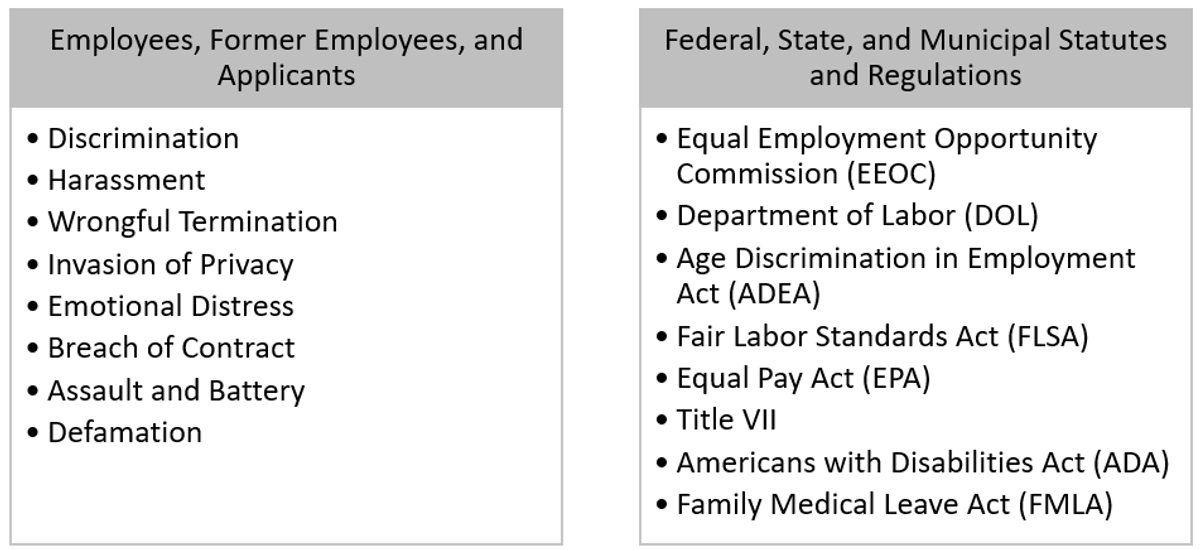
What Is EPLI Insurance?
·
13 minute read
Did you know?
- 318 days is the time it takes for the average EPLI claim to be resolved
- 24% of matters result in a settlement
- $160,000 is the average cost for cases that
result in a defense and settlement payment - 76% of cases result in no payment by the
insurance company.
*Source: Hiscox Guide to Employee Lawsuits
As an employer, you have a tremendous responsibility. You are responsible for not only adhering to numerous laws, but also for handling extremely sensitive situations on a daily or weekly basis.
But the fact remains, most employers aren't employment lawyers, and even if they were, it would be impossible to keep up with laws and run a business.
For example, listed below are just six of the various federal laws that employers must comply with.
- Title VII of the Civil Rights Act of 1964 (Title VII)
- Equal Pay Act
- Americans With Disabilities Act (ADA)
- Age Discrimination in Employment Act (ADEA)
- Fair Labor Standards Act (FLSA)
- Family Medical Leave Act (FMLA)
Have you read them all? Do you know how to comply with them? If you are like most business owners, you haven’t.
There are many more laws, along with specific state requirements, that are just as important. Also, social movements such as #metoo are rapidly bringing awareness to employment issues and the results are more legislation and increased business liability.
To compound the increased liability your business faces from mistakes, you have to defend yourself from accusations in both court and the court of public opinion. The consequences can be disastrous, even if you did nothing wrong.
In addition to monetary and reputational damages, poorly managed employment issues have the potential to affect your business in other ways, too.
They can decrease productivity while the affected claimant, as well as the company representatives, attend meetings and court hearings. It can also affect your other employees as they become aware of and are distracted by the situation.
To protect your business, it’s a good idea to get Employment Practices Liability Insurance (EPLI). What is EPLI insurance, as it’s commonly called? It is a critical insurance policy that provides coverage in case a claim is filed against your company. This insurance policy can help pay for the monetary costs and provide expertise and guidance throughout the entire claims process, making your business less vulnerable.
Looking For EPLI Coverage?
Easy quotes from multiple insurance companies.
What does EPL insurance cover?
Employment practices policies differ depending on your needs and the specific risks of
your business, but most EPLI policies will cover the following:
- Wrongful termination
- Discrimination
- Sexual harassment
- Retaliation
- Employment-related defamation
- Invasion of privacy
- Failure to promote
- Deprivation of career opportunity
- Negligent evaluation
Limited EPLI coverage can sometimes be purchased with your liability insurance package, but for more thorough and robust coverage, you will need to purchase coverage as a standalone policy or as part of your management liability program.
Who can file an EPLI claim against you?
Employment practices claims generally arise from individuals or governments. It is a commonly held belief that as an employer, liability in employment matters can only arise from an employee. However, claims can also come from former employees, applicants, third parties (customers and the public), and government bodies.

Common Employment Practices Liability Claims
Although numerous claims scenarios can happen, there are common trends that claim data shows.

*Source: E-Risk Services

As you can see, discrimination is the largest claim category for EPLI incidences, according to E-Risk Services.
When you look further into the discrimination category, you can see that most of the claims are arising from gender or race issues.
EEOC Proceedings should always be reported as soon as notice of any action is received. Waiting to see if they turn into something is the single most frequent way to end up with a
denial for late reporting.
EPLI Coverages You Need
Wage And Hour Coverage
A wage and hour dispute is the allegation that an employee’s workplace failed to compensate them according to the hours they worked. These laws typically vary by state and can lead to a class action lawsuit. Given the recent popularity of these lawsuits and the massive exposure, most employment practices insurance policies exclude wage and hour claims.
You can purchase a wage and hour endorsement to add defense coverage for these types of claims. The policy will usually not cover settlement or judgment payments, but it will give you a sublimit (e.g. $100,000 to $500,000) to hire a defense team.
Third-Party Coverage
While the intent of most employment practice insurance policies are to protect an organization from employment disputes, there is still a coverage gap that involves potential liability from the non-employee public.
If you have employees who interact with customers outside of your control, you have high exposure to a third-party EPLI claim.
Third-party coverage extends the employers’ liability insurance policy to cover claims made outside the organization.
Examples From The Travelers Claims Library
Discrimination And Harassment – $287,500
“In 2004, the plaintiff, a graphic designer hired in 2001, resigned her employment claiming that she had been subjected to sexual harassment and gender discrimination. Specifically, she
named four managers/directors of the insured as wrongdoers. The insured performed a thorough investigation and terminated three of the four people involved. The evidence collected included a long series of sexually explicit emails, jokes, and comments in the
workplace. The claimant was making $45,000 per year. Travelers paid $50,000 to defend the case before settling for $237,500.”
Wrongful Termination And Retaliation – $600,000
“A hospital employee complained that the hospital had initiated a number of policies that resulted in inadequate nurse to patient ratios, use of unqualified nursing staff, and falsification of hospital staff training records. The plaintiff alleged retaliation and was eventually terminated in response to plaintiff's attempts to modify the hospital's policies. In the lawsuit, the plaintiff asserted the following causes of action: wrongful termination in violation of public policy, infliction of emotional distress, slander, and violation of the Business and Professions Code. The case was settled for $400,000 and defense expenses were an additional $200,000.”
Breach Of An Implied Contract – $265,000
“A former employee sued a technology company, alleging that he was hired to be the VP of Sales and Marketing. He claimed that items promised to him were taken away (i.e., secretary, car allowance, staff levels, etc.) and that, when he allegedly failed to meet sales targets, he was wrongfully terminated. The plaintiff brought various breach of contract claims, including a claim for a breach of an implied agreement, which sought to recover benefits, punitive damages, interest, and fees. After numerous failed mediations, the matter settled for $200,000, with $65,000 in legal defense fees. Travelers contributed a portion of the
settlement and paid the legal fees.”
*Source: Travelers Claims Library
Additional Benefits To Having EPL Insurance
Free Legal Consult
The majority of standalone EPLI policies come with some form of HR Helpline, which you can call to ask an employment attorney how to handle a specific situation.
Although this can be helpful for any business, this is especially useful for small to medium-sized businesses that don’t have an HR attorney on staff.
More Freedom To Run Your Business
Only 24% of employment-related claims lead to a settlement, and they take an average of 318 days to resolve. Without an EPLI policy, there is a high risk that an employment matter could take you and your leadership team away from leading your company to focus on frivolous legal matters.
An EPLI policy will put together a defense team and strategy that will take the majority of the burden off your executives, so the time trade-off isn’t so severe.
As a business leader, sometimes you have to take risks and make hard decisions. For many leaders, there will come a time when they need to lay off employees. Situations like employee layoffs can lead to a multitude of employment lawsuits, but an EPLI policy allows you to make those tough decisions without worrying if the legal liabilities could bankrupt the company.
How Companies Can Avoid An EPLI Claim
Purchasing an employment practices liability insurance policy is only one way to address the risks of being an employer. There are multiple other ways you can protect your business, such as:
Implement additional employee/supervisor training with a zero-tolerance policy for discrimination and harassment.
The single best way to eliminate employment practices risk is to make sure your supervisors, managers, and executives have training on how to interact with employees, deal with tough situations, and follow proper reporting and documentation procedures.
Additionally, having clear boundaries and expectations for employees, such as a zero-tolerance policy for discrimination and harassment, will help eliminate these risks from your business as employees will know there are ramifications for prohibited behavior.
Document employment policies and procedures.
Having clear guidelines and procedures in your organization that are reviewed by an attorney is critical to avoiding employment practices claims. Documentation that can protect your organization from this type of litigation includes employee handbooks, grievance procedures, performance review processes, promotion and demotion procedures, and hiring and firing procedures.
Having written (and attorney approved) procedures that are enforced equally will not only minimize the number of incidents, but also keep incidents from escalating within the organization.
Investigate every incident of harassment and give employees a method for reporting grievances.
Be sure to provide a method—or ideally, multiple methods—for employees to report workplace grievances. At least one of the channels to report a grievance should not involve the employee’s direct supervisor.
Once you set up a way for employees to report incidents, we recommend that you create a procedure to investigate and document every single incident of harassment or discrimination. Taking these reports seriously and documenting your findings is critical if the employee were to escalate the incident to a lawsuit.
Document every incident and remain consistent.
Restating what has been said above, regardless of the type of incident or the reason for a termination, you should be documenting everything and remaining consistent in how you handle every event.
Even if you did nothing wrong, it will be much more difficult to fight a discrimination or harassment lawsuit if rules and procedures are applied differently to certain employees or employee groups.
A relentless dedication to consistency and documentation when handling HR and certain management matters will save your organization time and money in the long term.
Summary
- Employers are facing increasing legal obligations while managing their workforces
- There has been increased awareness and visibility of employment-related lawsuits
- Settlements can have a significant impact on your company's financial stability
- Cost to defend against employment suits is high regardless of the outcome
- An employment lawsuit, if not handled properly, can cause irreparable harm to your company's reputation
If employment matters are something you want to be covered with your business insurance program, you can talk to one of our risk advisors. We can help guide you through the process of obtaining a policy, as well as give you resources to avoid issues in the future.
About The Author: Austin Landes, CIC
Austin is an experienced Commercial Risk Advisor specializing in and leading LandesBlosch's design professional, real estate, and construction teams.
